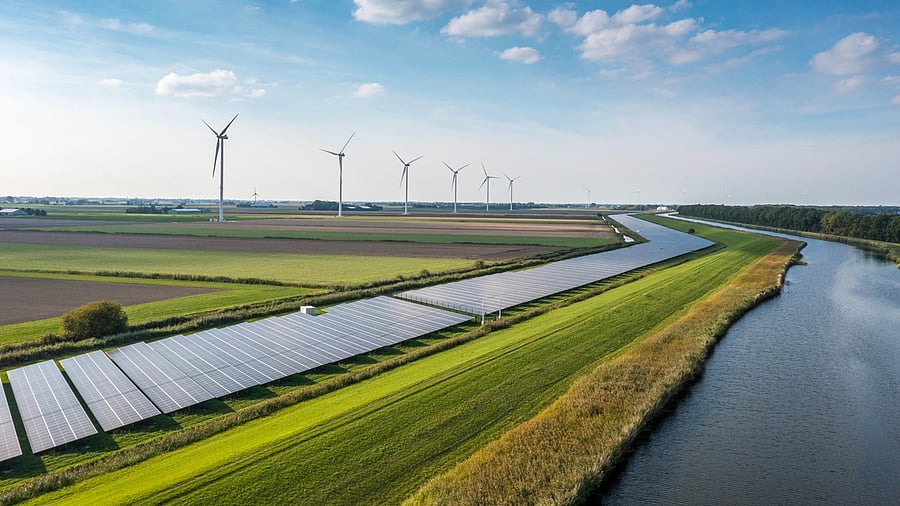
Representative image of clean energy.
Credit: iStock Photo
The transition to clean energy presents challenges related to critical minerals and energy security, which are essential for modern technology. These minerals are necessary for producing solar panels, semiconductors, wind turbines, and advanced batteries. A resilient supply chain for these minerals is crucial for major economies, as the energy transition cannot proceed without them.
India's economic future will depend on effectively utilising our mineral resources, while adapting to the global shift toward zero emissions. To assess this, a three-stage evaluation process will be implemented by the Ministry of Mines, Government of India, to analyse resource availability, production, import dependence, and the potential for future technologies.
Among the 30 identified critical minerals, 10 rely entirely on imports. Clean energy technologies, such as solar PV plants, wind farms, and electric vehicles (EVs), require significantly more minerals than traditional systems. For instance, electric cars need six times more minerals than conventional cars, while onshore wind plants require nine times more than gas-fired plants.
Key minerals vary by technology: lithium, nickel, cobalt, manganese, and graphite are vital for batteries, rare earth elements are crucial for motors in wind turbines and EVs, and electricity networks demand large amounts of copper and aluminium.
As clean energy adoption accelerates, the energy sector is expected to play a crucial role in mineral markets. By 2040, demand for critical minerals is projected to rise significantly, with over 40 per cent of the total demand for copper and rare earth elements and nearly 90 per cent for lithium driven by clean energy technologies.
Meeting the goals of the Paris Agreement may require our mineral needs to quadruple by 2040, and achieving net-zero emissions by 2050 will demand six times more minerals than today, particularly for EVs and battery storage, with lithium needs expected to grow more than 40 times.
The low-carbon power sector could triple mineral demand by 2040, primarily due to wind energy. However, uncertainties remain, such as cobalt demand potentially increasing by six to 30 times, depending on advancements in battery technology. This transition presents new vulnerabilities for energy security.
Current supply and investment strategies are inadequate, raising the risk of costly energy transitions. While historical supply-demand imbalances have moderated demand and spurred investment, these adjustments often involve time lags and price volatility that could hinder clean energy efforts.
Raw materials account for a significant portion of energy transition costs. Despite a 90 per cent drop in lithium-ion battery costs over the past decade, raw material prices now represent 50-70 per cent of total battery expenses. A doubling of lithium or nickel prices could lead to a 6 per cent increase in battery costs, counteracting cost reductions from higher production. Rising prices for copper and aluminium may also impact grid investments.
The near-term supply outlook is mixed: lithium raw materials and cobalt are in surplus, while lithium chemicals and battery-grade nickel could face shortages. Projections indicate that existing mines will only meet half of the projected lithium and cobalt needs and 80 per cent of copper requirements by 2030.
Current supply and investment plans are insufficient for accelerating energy transitions, exposing several key vulnerabilities, which are:
Concentrated Production: A few countries, particularly the Democratic Republic of the Congo (DRC), and China, dominate essential mineral production, creating geopolitical supply risks.
Long Development Times: Mining projects typically take about 16.5 years to develop, making it difficult to quickly increase supply in response to rising demand, potentially leading to market tightness.
Declining Ore Quality: The quality of minerals is decreasing; for instance, copper ore in Chile has seen a 30 per cent decline in grade over the past 15 years, raising costs and environmental emissions.
Environmental and Social Concerns: Mineral production poses environmental and social challenges, necessitating sustainable practices to avoid supply chain disruptions.
Higher Exposure to Climate Risks: Mining, particularly for copper and lithium, is increasingly vulnerable to climate risks, with over 50 per cent of production occurring in water-stressed areas.
Managing these risks is crucial for supporting clean energy transitions. Unlike oil crises, mineral shortages primarily impact EVs and solar plants. Many minerals can be recycled, posing different challenges compared to fossil fuels.
To address these issues, significant investment in mineral supply is essential. Policymakers need to provide clear signals to encourage timely investments and diversify sourcing options. Advances in technology, such as improved solar cells and enhanced recycling methods, can also help alleviate supply pressures.
India is focused on reducing risks in sourcing critical minerals by exploring new international resources and boosting domestic production. A report from the Institute for Energy Economics and Financial Analysis (IEEFA) underscores the importance of strong bilateral relations with mineral-rich countries like Australia, Chile, Ghana, and South Africa. It highlights India's reliance on China for graphite and recommends partnerships with Mozambique, Madagascar, Brazil, and Tanzania for greater security in this area.
Additionally, India’s dependence on Japan and Belgium for copper cathodes and nickel sulphates suggests a need to diversify toward the United States. While imports of lithium and nickel mainly come from Russia and China, developing domestic refining capabilities is crucial for integrating into the global supply chain.
The report emphasises the Government of India’s commitment to enhancing production through mining auctions and the Critical Minerals Mission, aiming to establish India as a global refining hub. A reliable supply of critical minerals is essential for meeting renewable energy targets of 500 gigawatts (GW) by 2030, and achieving net-zero emissions by 2070, which will require about 7,000 GW of renewable capacity.
Addressing the environmental and social impacts of mineral development is also critical. The International Energy Agency recommends investing in diverse supply sources and fostering international collaboration to ensure data reliability and promote sustainability standards.
Disclaimer: The views expressed above are the author's own. They do not necessarily reflect the views of DH.
Sunit Roy is a petrophysicist who retired as Group General Manager, ONGC.